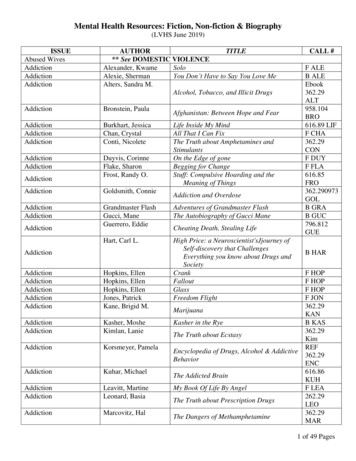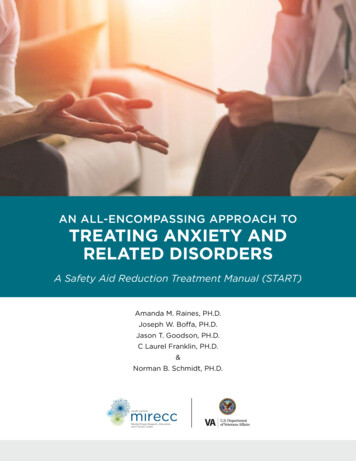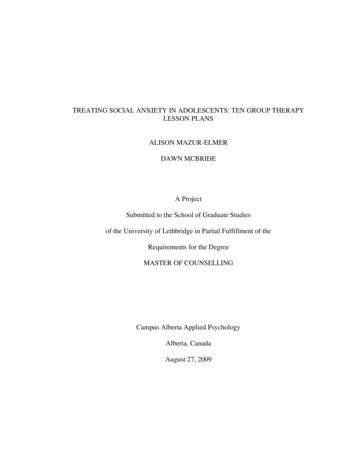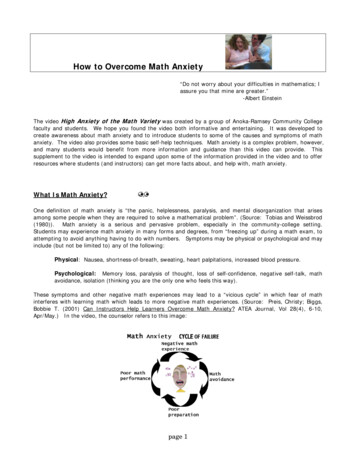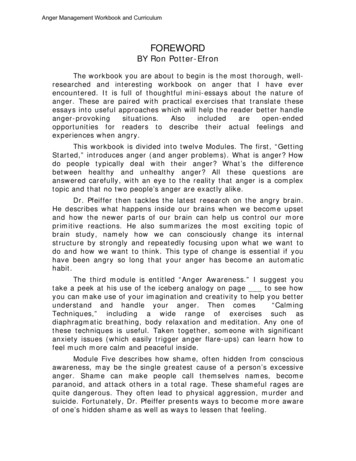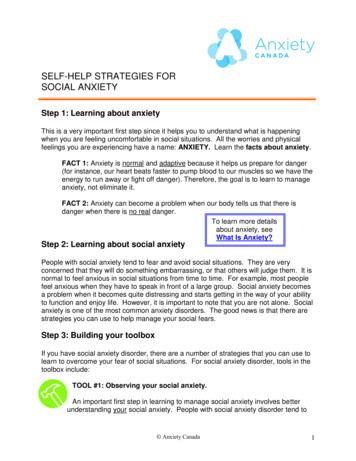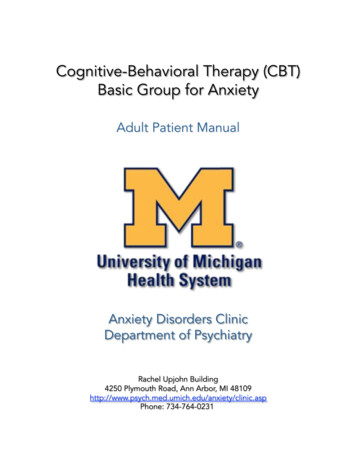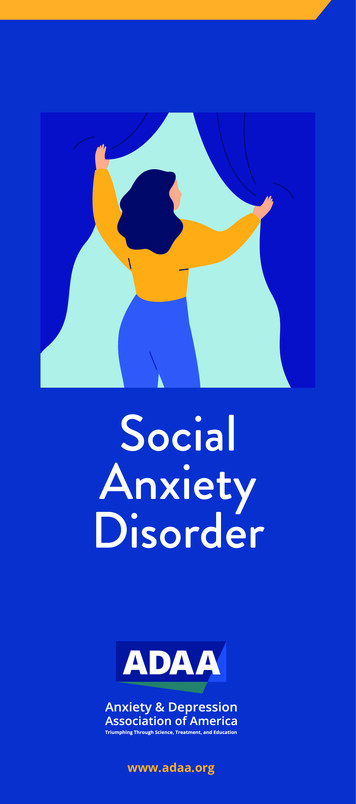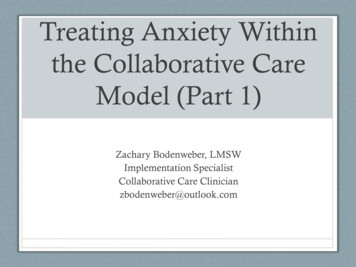
Transcription
Treating Anxiety Withinthe Collaborative CareModel (Part 1)Zachary Bodenweber, LMSWImplementation SpecialistCollaborative Care Clinicianzbodenweber@outlook.com
Acknowledgements Virna Little, LCSW-R, SAP, PSYD Amy Jones-Renaud, MPH Rita Haverkamp, MSN, PMHCNS-BC, CNS Cynthia Kim, LCSW-RIn reference to Integrated Care: Creating Effective Mental and Primary Health Care Teams by AnnaRatzliff, Jürgen Unützer, Wayne Katon, and Kari Stephens. University of Washington.Content for this presentation was adapted from the presentation Modular AnxietyTreatment by: Stacy Shaw Welch, PhDAnxiety & Stress Reduction Center of SeattleKari Stephens, PhDUniversity of WashingtonDepartment of Psychiatry & Behavioral Sciences
We will learn about 2018 Updates: Anxiety and CCMP Management and treatment of anxiety inCollaborative Care Best Practices Patient identification Patient engagement Psychoeducation Treatment Options Assessment, diagnosis, and differential diagnosis
Care Manager WorkflowIdentify upCare &Treat toTargetCompleteTreatment& RelapsePrevention
Collaborative Care MedicaidProgram (CCMP) 2018 Updates added the following Anxietydiagnoses: F41.9 - Unspecified Anxiety DisorderF41.1 - Generalized Anxiety Disorder (GAD)F41.3 - Other mixed anxiety disordersF41.8 – Other specified anxiety disorders Routine Screenings with GAD-2 GAD-7 Tracked and monitored same as PHQ-9 Held to the same improvement standards
Clinical Impact of Anxiety Due to multitude of somatic symptoms, anxietydisorder complicate diagnosis and treatment, oftenleading to increased medical costs Highly Associated with impaired general health andpsychosocial functioning Can worsen suicidal thinking and be a risk factor forsuicide attempts
Identify EngageIdentify upCare &Treat toTargetCompleteTreatment& RelapsePrevention
Working as a Team PCP: Recognize the signs of possible anxiety disorder(s),perform/review screening of symptoms (GAD-7), gatheradditional history, consider potential medical causes,educate, coordinate with Care Manager Care Manager: Complete assessment of symptoms andfunctional impairment, safety plan (if indicated), providepsychoeducation, engage, discuss treatment options Psychiatric Consultant: Clarify, determine, and/or refinediagnosis. Request further information. Craft treatmentrecommendation.
1) Identify EngageIdentify Screening Clinical ManifestationsEngage Warm hand-off The Pitch
Identify Screen GAD-2 GAD-7 Reliable and valid for Generalized Anxiety Disorderscreening in primary care Both count toward Anxiety screening rateIf positive, administer GAD-7
Identify GAD-7 Score 10 Persistent and excessive worrying Distinguished in GAD by having greater worry over minor matters Other clinical manifestations: HyperarousalAutonomic hyperactivityMotor tensionPoor SleepFatigueDifficulty relaxingHeadachesNeck, shoulder, and back painMedically unexplained concernsFrequent visits with health professionals
Engage Warm Hand-off Introduce yourself Gather information The Pitch Educate Inform Discuss treatment options
Warm Handoff Introduce the collaborative care manager as amember of the primary care team A colleague who specializes in behavioral healthtreatment or treatment patients who are feeling(“overwhelmed, stressed, sad, etc.”). Explain that the care manager works closely togetherwith PCP to provide the best treatment possible forthe patient’s symptoms
Gather Information Presenting symptoms/problems Stressors Supports Substance use (current historical) Treatment history Current and past medications Side effects Past psychotherapy and/or psychiatric treatment Medical problems (current historical)
Gain Understanding What situations? When during the day? What are they thinking/doing? What can’t they do because of anxiety? How does anxiety hold them back? What do they avoid?
Rapport Builders Reflective Listening Paraphrasing Summarizing Clarifying Empathizing Validating Understand and Appreciate
The PitchPart 1: Educate Inform Provide Brief Psychoeducation Anxiety Emotional fear response to threat Identify cues and contributing factors Generate hope (realistic) Identify treatment expectations Normalize Reduce stigma fault/blame/shame We are wired for survival The avoidance of pain is a powerful motivator Learned behavior
Educate and Inform The goal is to demystify anxiety Explain the anxiety is a normal part of life Anxiety is a normal reaction that has become too intenseor triggered at times it is not needed “Car Alarm” or “Guard Dog” Anxiety disorders are the result of genetic factors, learnedbehavior, and habit Can be treated most effectively with a combination ofbehavioral approaches and medications
The PitchPart 2: Discuss Treatment Options Level of Functioning Symptom Severity Patient Preference Explain the process of each Set expectations Discuss pros and cons
Intervention Types1. Talk Treatment or IndividualCounseling2. Medication Management3. Watchful Waiting or MonthlyMonitoring
Talk Tx or Medication? Both? CBT and Serotonergic Antidepressants Best studied and most efficacious for GAD No head-to-head comparisons of CBT and serotonergicantidepressants Meta-analyses have found equivalent effect For patients with significant impairment to functioning andsymptom severity, medications may be needed as initial treatmentbefore engagement and participation in talk treatment Robust evidence base supporting behavioral approaches foranxiety treatment Patient preference is a good start for most, but behavioralapproaches should remain a priority
Patient Preference What is patient preference impacted by? Beliefs associated with treatment Medication and Talk Treatment Past treatment experiencesStigma/BiasFamily/peer treatmentSide effectsTime needed These concerns should be anticipated and addressed indiscussion of treatment options
Watchful Waiting Patient’s with more mild symptoms and nosignificant impairment to functioning mayreasonably elect for forgo treatment initially Clinical follow-up is still important to monitor thecourse of the disorder and determine change tosymptoms severity or impact This can occur in monthly contact with caremanager, at which time GAD-7 is administered
Telephonic Encounters Include telephone use in discussion of treatment options Many patients (and clinicians) are not used to thistreatment option Offers a flexible, patient-centered option that improvesaccess engagement CBT for Anxiety can be effectively delivered over thephone Set expectations DurationFrequencyContentDate/Time
Establish a DiagnosisIdentify upCare &Treat toTargetCompleteTreatment& RelapsePrevention
2) Establish Diagnosis Understanding Anxiety Generalized Anxiety Disorder Diagnostic Criteria Differential Diagnoses Comorbidity
Physiology Parasympathetic Nervous System Rest DigestGreen ZoneConserves EnergySlower heart rate Sympathetic Nervous System Fight-or-FlightRed ZoneAccelerated Heart RateWidened Bronchial PassagesIncreased muscle blood flow and tensionIncreased perspiration and blood pressure
Stress The body’s response to demand from theenvironment Stress can be good or bad Stress Recovery Growth Useful stress activates us, initiates action Bad stress occurs when situational demands exceeda person’s coping resources
Effects of Stress on the Body Health
Anxiety Emotional Fear ResponseFearFocused responseto a known orENERALIZED ORdefinite threat GOVER-LEARNED Fight-or-flightresponse Necessary for survivalUseful (acute):activates us, gets usgoing
Anxiety Fear response to perceived threat AnticipatoryPossibleUniversal experienceReaction to various stimuli (some stronger than others) Fears are often learned through the construction ofmeaning: Life Experience Evolutionary Origin Everyone has a different threshold and different cues
Anxious Behavior Reframing "dysfunctional” behavior is a critical steptoward empowerment for positive change. Even behavior that seems problematic and has negativeconsequences (e.g., substance use) needs to be thought ofas an attempt to cope with and adapt to life stressors oreven a biological predisposition/neurochemical problem Every behavior meets a need. To help someone change,we must understand what is driving their currentbehavior. Many times it’s the learned relief of pain. It’sprotection. This is useful to remember in communicating with boththe patient and the care team
Safety Behaviors:Feel Good Now, But Hurt LaterAnxious people oftenengage in a range ofbehaviors to makethemselves feel safer whenthey cannot avoid anxioussituationsAlthough these behaviorscan facilitate functioning,they also prevent recoveryThese behaviors areattempts to neutralizefeelings of anxietyExamples: Reassurance seeking Behavioral rituals Safety cues/objects Over-preparation
Initial Diagnosis PCP: evaluate potential medical causes/origins ofanxious symptoms, order labs/tests as needed,coordinate with care manager, arrange for furtherassessment Care Manager: provide further assessment,communicate relevant/important information toPCP, screen for substance use, support patient onarranging follow-up, consult with psychiatricconsultant Psychiatric Consultant: provides expert guidance ondiagnosis as needed.
Rule-Out: Medical Cardiovascular: angina, arrhythmias, congestive heart failure,hypo/ertension, myocardial infarction (MI) Gastrointestinal: GERD, IBS, malignancy Hematologic: anemia Endocrine: hyperandrenalism, hypo/hyperthyroidism, endocrine tumor Immunological: anaphylaxis, lupus, MS Metabolic: hyponatremia, hypocalcemia, hypoglycemia Neurological: encephaloptahy, temporal lobe epilepsy, CNS tumor, TBI,vertigo Respiratory: asthma, chronic obstructive pulmonary disease (COPD),pneumonia, pulmonary embolism (PE)
Rule-Out: Substances Withdrawal: alcohol, opiates, sedatives, hypnotics Intoxication: digitalis, anticholinergics, caffeine,hallucinogens, cannabis, stimulants (stimulant use,caffeine overuse) Prescribed Medications: SSRIs and antipsychotics(both potential causing akathisia), bronchodilators,(e.g., theophylline, sympathomimetics), oral orinhaled steroids
Provisional Diagnosis Assess anxiety triggers for differential diagnoses: GAD: thought, worry Panic Disorder: physical sensations of panic “out ofthe blue” Social Anxiety Disorder: social situations PTSD: trauma reminders OCD: obsessive, intrusive thoughts If substance use is ongoing, asking about symptomswhen not using and the benefits of use
CCMP Diagnoses F41.9 - Unspecified Anxiety Disorder F41.1 - Generalized Anxiety Disorder (GAD) F41.3 - Other mixed anxiety disorders F41.8 – Other specified anxiety disorders
Generalized Anxiety Disorder GAD is one of the most common mental disorders in primarycare settings and is associated with increased use of healthservices Lifetime prevalence in US of 5.1% to 11.9% Twice as common in women as it is in men Most report they have felt anxious and nervous for entire life Broad range of onset Chronic and fluctuating symptoms Associated with a significant degree of functional impairment
GAD Characterized by excessive and persistent worrying that is hardto control, causes significant distress or impairment, and occurson most days Allocate extensive attentional resources to threatening stimuli Detect “threats” rapidly and effectively Misinterpret ambiguous information as threatening Intolerance of uncertainty Worrying serves a purpose (problem-solving or avoiding) Worrying about worrying
GAD Diagnostic CriteriaA) Excessive anxiety and worry (apprehensive expectation),occurring more days than not for at least 6 months, about a numberof events or activities (such as work or school performance)B) Individual finds it difficult to control the worryC) Associated with three (or more) of following for more days thannot Restlessness or feeling on edgeBeing easily fatiguedDifficulty concentrating or mind going blankIrritabilityMuscle tensionSleep disturbance
GAD Diagnostic CriteriaD) The anxiety, worry, or physical symptoms causeclinically significant distress or impairment in social,occupational, or other important areas of functioningE) The disturbance is not attributable to thephysiological effects of a substance or another medicalconditionF) To be continued
Diagnostic Features Worry about multiple events or activities, mostlyeveryday, routine life circumstances Intensity, duration, and frequency of worry is out ofproportion to the actual likelihood or impact ofanticipated event Difficult to control the worry and to keep worrisomethoughts from interfering with attention to tasks athand
Case Example22yo single Caucasian female in college presents withfeeling anxious for a few years. Her friends call her a“worry wart”. She worries about her grades, family athome, how she’ll pay her college loans when she graduates,how will she decide on a major, what will happen if shechooses the wrong major, the homeless population in herarea, upcoming presidential elections, and her dog’s healthto the point where she loses sleep and constantly has theseproblems on her mind. “If it isn’t one thing, it’s another.My mind can’t seem to relax.” She says that she can’t focusin class and her grades are slipping. For the past year shehas had tension headaches and neck pain.
What distinguishes GADworry? Excessive and interferes with psychosocial functioning More pervasive, pronounced, and distressing Longer duration Often occurs without precipitant stimuli Wider range of worry content (life circumstances) Accompanied with physical symptoms Reported subjective distress
Average Worry or GAD?Susie loves her mother dearly. Usually, she lights upwhen her mother calls and looks forward to their planstogether. However, Susie has been worried the last fewdays and her heart sinks when the phone rings. Shehasn’t been sleeping well and has not had much of anappetite. Last week, her mother told her about someconcerning findings at her last doctor appointment.She is waiting to hear back the results.
Average Worry or GAD?Meredith has been anxious for as long as sheremembers. It used to be school. She would alwaysworry about her test results and prepare excessively forexams. She proofread papers over and over to makesure there were no mistakes. She hoped that theanxiety would go away after school, but now she findsthe same thing in his career. She often gets to work 45minutes early so she is not late and she checks in withher boss excessively to make sure he is doing everythingok. Lately, she has big project that is due and she isbeginning to call out sick. She feels fatigued and tense.
Average Worry or GADBrandon often worries about people being mad at him. Whensomeone doesn’t answer the phone or text back, he becomesvery anxious and thinks about any way he might haveoffended them. He often replays conversations with coworkersin his head to make sure it went ok. If they didn’t laugh at ajoke of his, he will send an email to them with an unrelatedquestion and he will find it difficult to concentrate until theyrespond. He constantly feels like he is making mistakes atwork. He thinks he forgot to lock the drawer to his desk,where he has jolly ranchers, and he fears that if themaintenance man decides to have one he might choke and dieand it will be all his fault. He often feels his heart racing andhas shortness of breath.
Average Worry or GAD?Priscilla typically gets a little worried about herfinances. She works three jobs and doesn’t have muchtime for her children, so she also is concerned abouttheir upbringing, since they spend most of the timewith her unemployed sister. She tries to plan for herfuture and have enough savings put away to feed herfamily in case she gets fired, but is often concerns abouther children’s recent behavioral problems since she isnot around often. She keeps pressing on like she alwayshas.
What about F?F) The disturbance is not betterexplained by another mental disorder Because the majority of anxietysymptoms are not specific to GAD, itis important to rule out other anxietydisorders before making the diagnosis
GADPhobiasOCDSocialAnxietyPTSDPanic
Differential Diagnoses Anxious manifestations in other mental disorders Worrying about Having panic attacks (Panic Disorder)Negative evaluation (SAD)Contamination or other obsessions (OCD)Separation from attachment figures (Separation Anxiety)Reminders of traumatic events (PTSD)Gaining weight (Anorexia Nervosa)Perceived appearance flaws (body dimorphic)Physical complaints (Somatic Symptom Disorder)Delusional beliefs
Diagnostic ClarificationHave you had ? Worry, tension, or anxiety more days than not for 6months (GAD) Recurrent intrusive recollections of trauma oravoidance of trauma reminders (PTSD) Anxiety and avoidance in social situations (SAD) Sudden and unexpected anxiety or physicalsymptoms when no one around (PD)
Differential Diagnoses Anxiety disorder due to another medical condition Substance/medication-induced anxiety disorder Social anxiety disorder Obsessive-compulsive disorder Posttraumatic stress disorder Adjustment Disorder (w/i 3 months of identifiable stressor) Depressive, bipolar, and psychotic disorders Anxiety/worry is a common associated feature and should notbe diagnosed separately if it has only occurred during course ofthese conditions
Panic Disorder Symptoms peak within 10 minutes and last up to 3060 minutes Panic attacks occur out of the blue Persistent fear of having future panic attacks With or without agoraphobia Avoidance of places and situations where anattack has occurred or may occur.
Panic Disorder Difficulty breathing and/or choking sensation Pounding heart or chest pain Intense feeling of terror, of losing control or are about todie Dizziness or feeling faint Trembling or shaking, tingling or numbness Chills, sweating, and/or hot flashes Nausea or stomachache, sudden urge to defecate
Obsessive CompulsiveDisorder Obsessions Persistent & intrusive thoughts, feelings, images, impulses Recognized as product of own mind Causes marked distress Compulsions Repetitive, ritualized, or stereotyped physical or mentalactions Done to relieve anxiety “prevents” some future event Satisfies a rigid rule Time consuming ( 1 hour) or significant interference withnormal routine
OCD Case Example15 yo male is brought to the clinic by his mother because heis missing school and his grades have dropped. The ptreports that it’s hard for him to leave the house in themorning. Mother reports that he is driving her nuts becausehe won’t walk through the doorways in the house andmumbles something to himself each time he tries to walkthrough a doorway. “It can take him 30 minutes just to getfrom his bedroom to the living room, forget trying to get outthe front door”. He reveals that he also has to use papertowels to touch door handles and food products. “I knowthat sounds stupid, but I just have to”. Mother says she isafraid her son is psychotic with all the talking to himself.
PTSD The event involved actual or threatened death,serious injury, or assault Event causes powerful subjective responses Event causes intense fear, helplessness, or horror Trauma Exposure 38% of population is exposed to severe traumas andonly 9% develop the disorder
PTSD Avoidance of activities, places, thoughts, feelings, or conversationsrelated to the trauma Emotional numbing - Loss of interest, feeling detached from others,restricted emotions Re-experiencing the traumatic event Intrusive thoughts Flashbacks/Nightmares Exaggerated reactions to triggers Increased autonomic arousal Difficulty sleeping Irritability or outbursts of anger Difficulty concentrating Hypervigilance Exaggerated startle response
PTSD Case Example32 yo female with a history of rape and sexual abuse growing up.She reports that getting involved in serious relationships is verydifficult for her and she wants to start therapy to address this.Once in therapy she reveals a history of poor sleep, getting angryreally easily at her friends and co-workers, feeling jumpy, having ahard time being intimate with her boyfriend and feeling like shedoesn’t connect with him. She says that she feels uncertain abouther future and actually doesn’t imagine she’ll be someone wholives to be too old. She has occasional low mood. When askedspecific details about her past abuse, she says that she can’tremember what happened after the man grabbed her by the arm.At work she gets upset because she keeps picturing her uncletouching her. Sometimes if someone grabs her on the arm, shegets a sinking feeling in her stomach and feels her heart race.
Specific Phobia Marked and persistent fear that is excessive orunreasonable when exposed to object/situation or inanticipation of exposure Upon exposure, immediate anxiety (even a panic attack;in children may present as crying, tantrum, freezing,clinging) Person recognizes fear as excessive Avoid or endure with intense anxiety Impairment in some functioning or significant distress Specify type: animal, natural-environment, bloodinjection, injury, other
Specific Phobia Case ExampleJoe is a 55 year-old male. During the past year he was diagnosedwith diabetes and requires insulin injections. As a child he passedout once when having his blood drawn. Since then he has avoidedviewing or thinking about anything related to injections. He alsohad a panic attack when he had to walk by a blood donor clinic.He has been unable to manage his injections and has been unableto watch anyone give him the injections. He feels extremelyanxious leading up to injection times, and sometimes takes over anhour to allow the injection. Joe is often exhausted and upset forhours after an injection and this has interfered with his ability toattend work and upkeep responsibilities. Sometimes he avoidsinjections altogether. This behavior is leading to many argumentswith his wife and his doctor is very worried about his health.
Social Anxiety Disorder(Social Phobia) Marked and persistent fear of scrutiny andhumiliation in social situations Exposure leads to significant anxiety (e.g., acutestress reactions and/or panic attacks) Individual recognizes fear and response asunreasonable (not children)
Social Phobia ActivatingEvents Eating or drinking in front of others Writing or working in front of others Being the center of attention Interacting with people, including dating or going toparties, asking questions or giving reports in groups Using public toilets Talking on the telephone
Social Phobia Case Example26 yo African American female currently in college. Shepresents to individual therapy due to poor grades in college.In HS she was a straight A student. Since starting collegeshe has gotten C’s or D’s. “I have been skipping classbecause it is too stressful. One professor called on me in frontof 50 students and I knew the answer but it freaked me outso much, I haven’t been back” “I know this sounds stupid,but it’s like I can’t even cross the street right because I feellike people are watching me fidget and get nervous. Theymust think I am such an idiot” Pt reports she is also late onher rent and has been avoiding calling her landlord because“I’ll sound stupid”.
Anxiety Depression Most anxiety in clinical care is mixed with depression Generalized Anxiety Disorder (GAD) is 35-50% comorbidwith depression Untreated GAD is associated with high rates of medicalcomorbidity and medical care utilization Comorbid depression negatively impacts prognosis and oftenresults in prolonged course and increased functionalimpairment Neurotransmitters involved are serotonin, norepinephrine, andGABA Common heritability. Same biological underpinnings.
Overlapping Symptoms
Part 2!thApril 17 20182:30-4:00 PM ESTQuestions?zbodenweber@outlook.com
2018 Updates added the following Anxiety diagnoses: F41.9 - Unspecified Anxiety Disorder F41.1 - Generalized Anxiety Disorder (GAD) F41.3 - Other mixed anxiety disorders F41.8 - Other specified anxiety disorders Routine Screenings with GAD-2 GAD-7 Tracked and monitored same as PHQ-9


